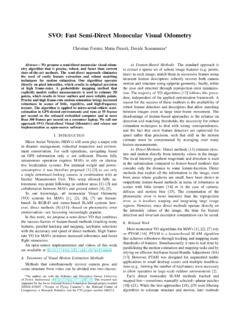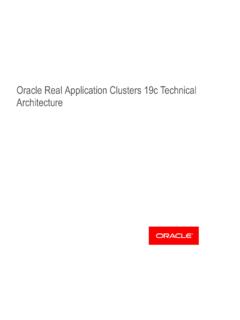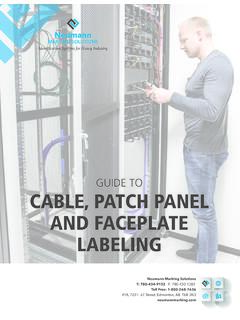Transcription of PatchMatch: A Randomized Correspondence Algorithm for ...
1 PatchMatch: A Randomized Correspondence Algorithm for Structural Image EditingConnelly Barnes1 Eli Shechtman2,3 Adam Finkelstein1 Dan B Goldman21 Princeton University2 Adobe Systems3 University of Washington(a)original(b) hole+constraints(c) hole filled(d) constraints(e) constrained retarget(f) reshuffleFigure 1:Structural image editing. Left to right: (a) the original image; (b) a hole is marked (magenta) and we use line constraints(red/green/blue) to improve the continuity of the roofline; (c) the hole is filled in; (d) user-supplied line constraints for retargeting;(e) retargeting using constraints eliminates two columns automatically; and (f) user translates the roof upward using paper presents interactive image editing tools using a newrandomized Algorithm for quickly finding approximate nearest-neighbor matches between image patches.
2 Previous research ingraphics and vision has leveraged such nearest-neighbor searches toprovide a variety of high-level digital image editing tools. However,the cost of computing a field of such matches for an entire imagehas eluded previous efforts to provide interactive performance. Ouralgorithm offers substantial performance improvements over theprevious state of the art (20-100x), enabling its use in interactiveediting key insights driving the Algorithm are thatsome good patch matches can be found via random sampling, andthat natural coherence in the imagery allows us to propagate suchmatches quickly to surrounding areas. We offer theoretical analysisof the convergence properties of the Algorithm , as well as empiricaland practical evidence for its high quality and performance.
3 Thisone simple Algorithm forms the basis for a variety of tools imageretargeting, completion and reshuffling that can be used togetherin the context of a high-level image editing application. Finally, wepropose additional intuitive constraints on the synthesis process thatoffer the user a level of control unavailable in previous [Computing Methodologies]: ComputerGraphics Methodology and Techniques; [Computing Method-ologies]: Image Processing and Computer Vision ApplicationsKeywords:Approximate nearest neighbor, patch -based synthesis,image editing, completion, retargeting, reshuffling1 IntroductionAs digital and computational photography have matured, researchershave developed methods for high-level editing of digital pho-tographs and video to meet a set of desired goals.
4 For example,recent algorithms forimage retargetingallow images to be resizedto a new aspect ratio the computer automatically produces a goodlikeness of the contents of the original image but with new dimen-sions [Rubinstein et al. 2008; Wang et al. 2008]. Other algorithmsforimage completionlet a user simply erase an unwanted portionof an image, and the computer automatically synthesizes a fill re-gion that plausibly matches the remainder of the image [Criminisiet al. 2003; Komodakis and Tziritas 2007].Image reshufflingal-gorithms make it possible to grab portions of the image and movethem around the computer automatically synthesizes the remain-der of the image so as to resemble the original while respecting themoved regions [Simakov et al.]
5 2008; Cho et al. 2008].In each of these scenarios, user interaction is essential, for severalreasons: First, these algorithms sometimes require user interventionto obtain the best results. Retargeting algorithms, for example,sometimes provide user controls to specify that one or more regions( , faces) should be left relatively unaltered. Likewise, the bestcompletion algorithms offer tools to guide the result by providinghints for the computer [Sun et al. 2005]. These methods providesuch controls because the user is attempting to optimize a set ofgoals that are known to him and not to the computer. Second,the user often cannot even articulate these goalsa priori.
6 Theartistic process of creating the desired image demands the use oftrial and error, as the user seeks to optimize the result with respectto personal criteria specific to the image under role of interactivity in the artistic process implies two prop-erties for the ideal image editing framework: (1) the toolset mustprovide the flexibility to perform a wide variety of seamless edit-ing operations for users to explore their ideas; and (2) the perfor-mance of these tools must be fast enough that the user quickly seesintermediate results in the process of trial and error. Most high-level editing approaches meet only one of these criteria.
7 For ex-ample, one family of algorithms known loosely asnon-parametricpatch samplinghas been shown to perform a range of editing taskswhile meeting the first criterion flexibility [Hertzmann et al. 2001;Wexler et al. 2007; Simakov et al. 2008]. These methods are basedon small ( 7x7) densely sampled patches at multiple scales, andare able to synthesize both texture and complex image structuresthat qualitatively resemble the input imagery. Because of their abil-ity to preserve structures, we call this class of techniquesstructuralimage editing. Unfortunately, until now these methods have failedthe second criterion they are far too slow for interactive use on allbut the smallest images.
8 However, in this paper we will describe analgorithm that accelerates such methods by at least an order of mag-nitude, making it possible to apply them in an interactive structuralimage editing understand this Algorithm , we must consider the common com-ponents of these methods: The core element of nonparamet-ric patch sampling methods is a repeated search of all patchesin one image region for the most similar patchin another image region. In other words, givenimages or regionsAandB, find for everypatch inAthe nearest neighbor inBunder apatch distance metric such asLp. We call thismapping theNearest-Neighbor Field(NNF),illustrated schematically in the inset this problem with a na ve bruteforce search is expensive O(mM2)for imageregions and patches of sizeMandmpixels,respectively.
9 Even using acceleration methodssuch asapproximate nearest neighbors[Mountand Arya 1997] and dimensionality reduction,this search step remains the bottleneck of non-parametric patch sampling methods, preventing them from attain-ing interactive speeds. Furthermore, these tree-based accelerationstructures use memory in the order ofO(M)or higher with rela-tively large constants, limiting their application for high efficiently compute approximate nearest-neighbor fields our newalgorithm relies on three key observations about the problem:Dimensionality of offset , although the dimensional-ity of the patch space is large (mdimensions), it is sparsely pop-ulated (O(M)patches).
10 Many previous methods have acceleratedthe nearest neighbor search by attacking the dimensionality of thepatch space using tree structures ( ,kd-tree, which can searchinO(mMlogM)time) and dimensionality reduction methods ( ,PCA). In contrast, our Algorithm searches in the 2-D space of pos-sible patch offsets, achieving greater speed and memory structure of , the usual independentsearch for each pixel ignores the natural structure in images. Inpatch-sampling synthesis algorithms, the output typically containslarge contiguous chunks of data from the input (as observed byAshikhmin [2001]). Thus we can improve efficiency by performingsearches for adjacent pixels in an interdependent law of large , whereas any one randomchoice of patch assignment is very unlikely to be a good guess,some nontrivial fraction of a large field of random assignments willlikely be good guesses.






